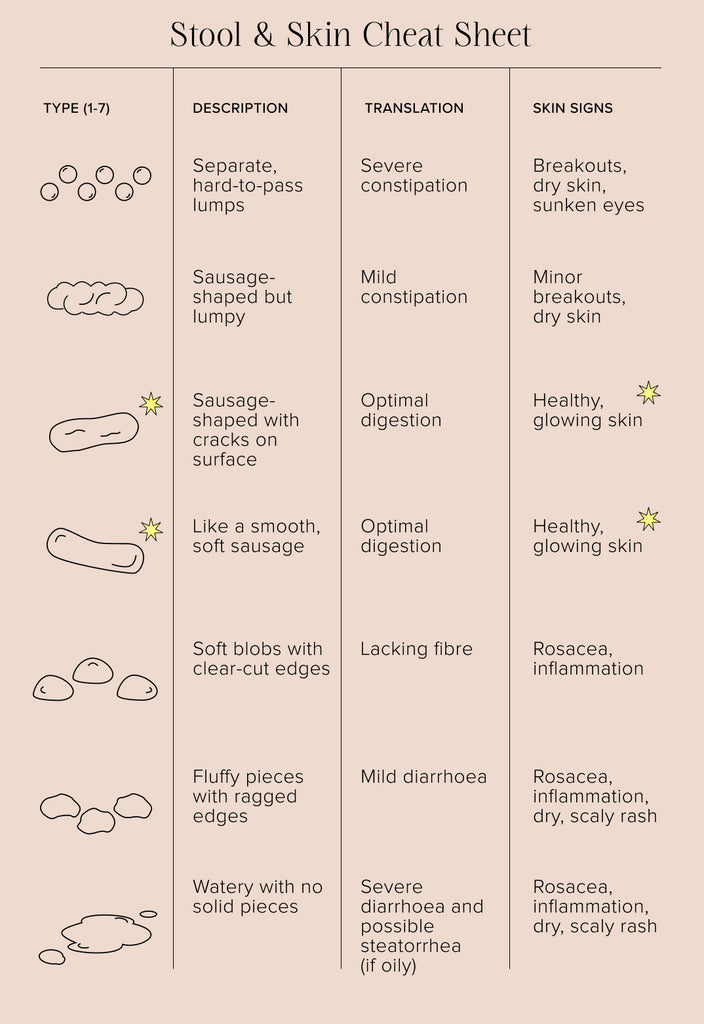
This isn’t the first (and probably won’t be the last) time we talk about poo. Though we may have already established what your poo says about your health, there’s still plenty of other clues your toilet time can give you... including hints about your skin.
That’s right, you may have heard of the gut-skin connection but how about the poo-skin connection? It’s not so much of a stretch when you consider the significant role your digestive health plays in both your bowel movements and healthy, glowing skin.
So if you’ve been trying to solve your skin concerns on the surface, it may be time to look toward the toilet bowl and begin to consider the underlying causes that can wreak havoc with your complexion.
Exploring the poo-skin connection
When it comes to different types of bowel movements, the Bristol Stool Chart has been used by medical professionals as a guide for years and can also be utilised for self-monitoring. When it comes to each type and how it correlates to the skin, that’s where individual digestive, diet and stool studies come in.
Breakouts: Skin congestion and breakouts are often connected to constipation, as rather than being expelled efficiently, waste and toxins can become reabsorbed into the body and therefore must exit via another detoxification organ—the skin. For example, one study involving over 13,000 adolescents showed that those with acne were more likely to experience gastrointestinal symptoms such as constipation, halitosis, and gastric reflux.
Dry skin and sunken eyes: Constipation can be increased by dehydration, which is why maintaining your water and fibre intake is important for encouraging optimal digestion. If a lack of fluid is contributing to the state of your bowel movements, you may also experience dry skin and sunken eyes.
Healthy, glowing skin: Types 3 and 4 on the Bristol Stool Chart are considered optimal—so if you identify mostly with these you can take it as a sign of good gut health and are more likely to have healthy, glowing skin as a result.
Rosacea and skin inflammation: Increasing your intake of dietary fibre (specifically prebiotics) will not only help to turn your Type 5 into a Type 4 but there’s evidence to suggest that it can help to reduce rosacea symptoms and protect against allergic skin inflammation. Those with rosacea have also been shown to have a higher prevalence of SIBO than the general population, of which common signs include diarrhoea, flatulence, abdominal pain and bloating.
Dry, scaly rash: Steatorrhea is one specific type of poo that’s likely to fall under Type 7 on the Bristol stool chart but has its own characteristic of appearing oily due to an increase of fat excretion in the stool. When fat intake, digestion, absorption, or metabolism are impaired, there is risk of Essential Fatty Acid Deficiency (EFAD)—clinical symptoms of which include scaly, dry rash and impaired wound healing.

5 win-wins for your bowels and skin
Your diet plays a significant role when it comes to healthy bowel movements and healthy skin. For smooth sailing inside and out, keep the following tips top of mind:
Focus on fibre: Aim to consume plenty of soluble and insoluble fibre—soluble fibre can help to improve digestion and lower blood sugar, while insoluble fibre can soften stool, making it easier to pass. Dietary fibre has also been shown to improve skin wound healing and contribute to a healthy skin barrier. Sources of insoluble fibre include bananas, berries, onions, garlic, Jerusalem artichokes, asparagus, leeks, celery and leafy greens. Soluble fibre is found in foods like chia seeds, oats, fresh fruits, vegetables and unrefined wholegrains. Fun fact: Kiwi fruit with the skin on contains a perfect ratio of soluble and insoluble fibre.
Keep hydrated: Increased water intake can help to reduce signs of dryness and roughness in the skin while increasing elasticity. Not to mention healthy hydration levels help to support digestion—faecal composition is 70-75 per cent water, after all!
Go tropical: Papaya and pineapple are rich in digestive enzymes, which have been shown to improve digestion capacity of dietary protein. Additionally, papaya helps to digest fats, which can aid in lowering stool fat excretion in patients with pancreatic steatorrhea (aka oily poo). Plus, both fruits provide a dose of vitamin C, which is essential for collagen synthesis, wound healing and healthy skin.
Embrace fermented foods: Promote a healthy gut by reaping the beneficial bacteria found in fermented foods such as yoghurt, kombucha, kimchi, kefir, sauerkraut, pickles and miso. One study also found that kefir can significantly improve the condition of the skin, particularly hydration.
Promote calm and take care: Constipation has been linked to those who experience stressful negative emotions, including anxiety, depression, tension and fatigue. Stress is also known to trigger skin conditions such as acne, atopic dermatitis, psoriasis and pruritus, as well as exacerbate skin damage and ageing—just in case you needed an extra reason to book that massage.




